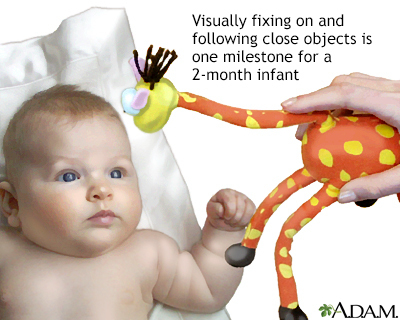Developmental milestones record - 2 months
Definition
This article describes the skills and growth targets of 2-month-old infants.
Alternative Names
Normal childhood growth milestones - 2 months; Childhood growth milestones - 2 months; Growth milestones for children - 2 months
Information
Physical and motor-skill markers:
- Closing of soft spot at the back of the head (posterior fontanelle)
- Several newborn reflexes, such as the stepping reflex (baby appears to dance or step when placed upright on solid surface) and grasp reflex (grasping a finger), disappear
- Less head lag (head is less wobbly on the neck)
- When on stomach, able to lift head almost 45 degrees
- Less flexing of the arms and legs while lying on the stomach
Sensory and cognitive markers:
- Beginning to look at close objects.
- Coos.
- Different cries mean different things.
- Head turns from side to side with sound at the level of the ear.
- Smiles.
- Responds to familiar voices.
- Healthy babies can cry up to 3 hours per day. If you are worried that your baby cries too much, talk to your health care provider.
Play recommendations:
- Expose your baby to sounds outside those of the home.
- Take your baby for rides in the car or walks in the neighborhood.
- The room should be bright with pictures and mirrors.
- Toys and objects should be bright colors.
- Read to your baby.
- Talk to your baby about objects and people in their environment.
- Hold and comfort your baby if they are upset or crying. DO NOT worry about spoiling your 2-month-old.
Gallery

References
Centers for Disease Control and Prevention website. Infants (0-1 year of age). www.cdc.gov/ncbddd/childdevelopment/positiveparenting/infants.html. Updated February 22, 2021. Accessed April 6, 2021.
Onigbanjo MT, Feigelman S. The first year. In: Kliegman RM, St. Geme JW, Blum NJ, Shah SS, Tasker RC, Wilson KM, eds. Nelson Textbook of Pediatrics. 21st ed. Philadelphia, PA: Elsevier; 2020:chap 22.